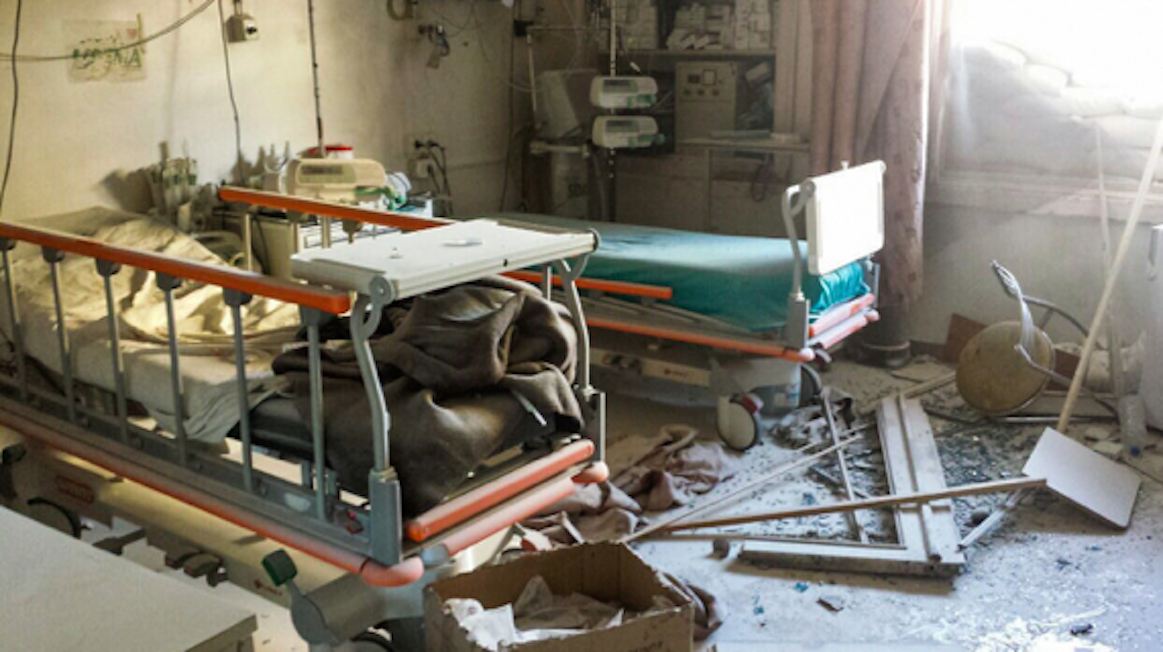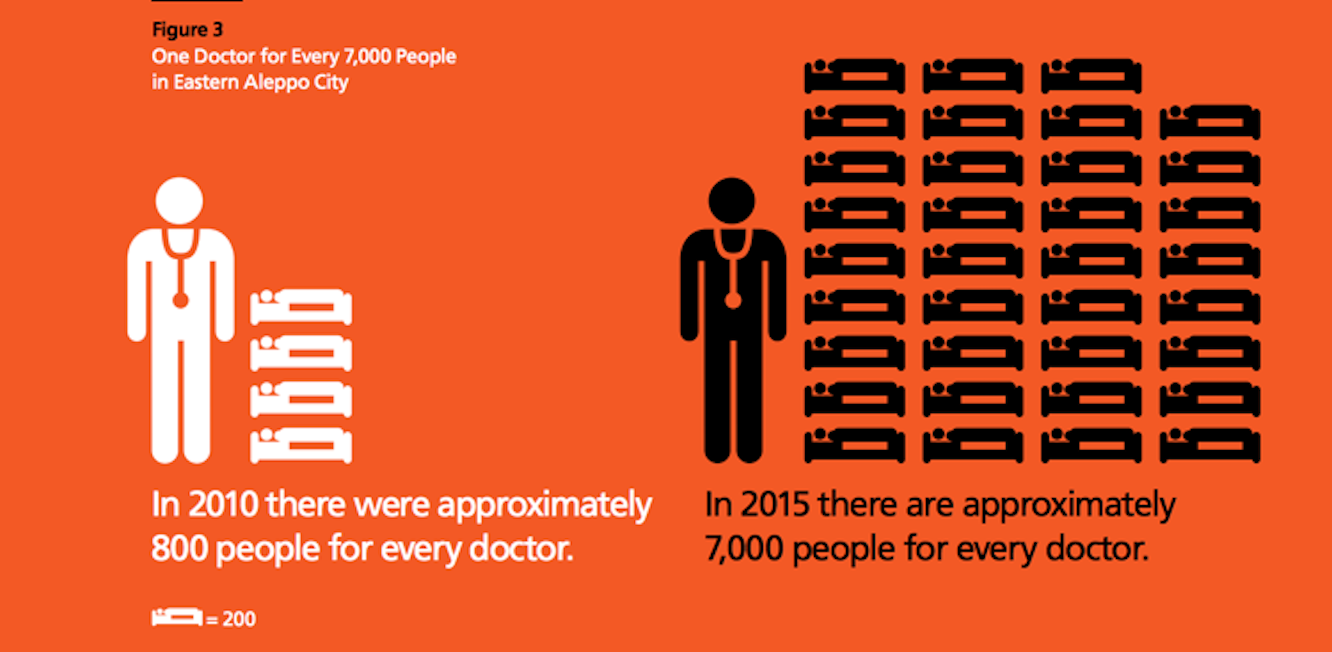The Doctors of Aleppo
Background to the Crisis
The Syrian Civil War grew out of nationwide protests against President Bashar al-Assad beginning on March 15, 2011, as part of the Arab Spring. By the end of 2011, full-scale fighting had erupted between![]() Syrian government forces and a loose and ever-changing coalition of opposition and rebel groups with a wide range of ideologies and goals. To date, close to half a million people have died. In 2016, the United Nations identified 13.5 million Syrians requiring humanitarian assistance, of whom more than 6 million are internally displaced within Syria and more than 4.8 million are refugees outside of Syria.
Syrian government forces and a loose and ever-changing coalition of opposition and rebel groups with a wide range of ideologies and goals. To date, close to half a million people have died. In 2016, the United Nations identified 13.5 million Syrians requiring humanitarian assistance, of whom more than 6 million are internally displaced within Syria and more than 4.8 million are refugees outside of Syria.
In Aleppo, Syria’s largest city, large protests did not begin until May 2012. The relative peace in Aleppo ended in July 2012, when rebel fighters infiltrated the city. This set off a four-year confrontation that was variously called a battle, a siege, and a stalemate. Throughout the conflict in Aleppo, the Syrian government disregarded international humanitaria law and intentionally attacked locations where civilians would gather, such as markets, places of worship, and hospitals. Medical facilities in eastern Aleppo, which was under the control of rebel groups, were attacked over 300 times. Toward the end of 2016 came allegations that the Syrian government, which had already been accused of using poison gas against rebel fighters and civilians, was using white phosphorus and other forms of illegal chemical warfare.
Additional Information about the Rescuers
In 2010, Aleppo had approximately one doctor for every 800 inhabitants. By 2015, there was only one doctor for every 7,000 people. Ninety-five percent of Aleppo’s doctors fled to neighboring countries or to Europe., and in 2014 Médecins Sans Frontières (Doctors Without Borders) withdrew its medical personnel from the Aleppo area out of fear of abductions by ISIS. In the months to come, many of the remaining medical personnel would be killed in airstrikes and a surface-to-surface missile attack.
Medical personnel in eastern Aleppo and towns in the nearby countryside found themselves on the front line in a deadly conflict zone in which the Syrian government’s strategy was to empty an entire city, town or village of residents by targeting hospitals and infrastructure (water and electricity) in advance of a ground invasion.
The effort by the Syrian government (eventually in conjunction with Russian forces) to regain control of Aleppo included an unprecedented number of attacks on hospitals. In early March 2016, Tirana Hassan of Amnesty International stated that Syrian and Russian forces were “deliberately attacking health facilities in flagrant violation of international humanitarian law. But what is truly egregious is that wiping out hospitals appears to have become part of their military strategy.”
Deliberate attacks on civilians not directly participating in hostilities and on civilian objects such as hospitals are war crimes. Under the laws of war, hospitals and medical units enjoy special protection, and they lose protection from attacks only if they are being used for non-humanitarian, military functions such as storing weapons. Amnesty International asserted that no evidence had been found of any military vehicles, checkpoints, fighters or front lines near the hospitals that were attacked.
Timeline
2011 (March 15) Syrians citizens demand the release of school children who have been arrested and tortured for anti-government graffiti
2012 (May) First large anti-government protests in Aleppo; (July) Aleppo infiltrated by rebel groups
2013 (December) The Syrian government starts using barrel bombs, triggering large-scale civilian evacuations from eastern Aleppo
2014 Médecins Sans Frontières (Doctors Without Borders) medical personnel withdrawn from Aleppo
2016 (April 27) Dr. Muhammad Waseem Moaz, killed in an attack on the al-Quds Hospital, is mourned as "the last pediatrician of Aleppo"
2016 (July) Siege of rebel-controlled eastern Aleppo begins; (July 23) Al-Daqaq Hospital, which treats 150 patients daily, is bombed and forced to close
2016 (August 11) Fifteen of the remaining doctors in eastern Aleppo send a letter to President Barack Obama asking for action to lift the siege and to protect civilians
2016 (November) The four remaining hospitals in eastern Aleppo can no longer function
2016 (December) A ceasefire is initiated, then fails; three days later, on December 18, the ceasefire is reinstated, the remainder of eastern Aleppo is evacuated, and the conflict is considered over.
Primary and Other Sources
“Aleppo Abandoned: A Case Study on Health Care in Syria.” Physicians for Human Rights, Nov. 2015, https://s3.amazonaws.com/PHR_Reports/aleppo-abandoned.pdf.
I Am Syria. Syracuse University College of Law Impunity Watch and The Summer Institute for Human Rights and Genocide Studies, 2015, http://www.iamsyria.org/.
“Syria.” Human Rights Watch, https://www.hrw.org/middle-east/n-africa/syria.
Syria Conflict Mapping Project. The Carter Center, https://d3svb6mundity5.cloudfront.net/dashboard/index.html.
Taleb, Ziyad Be, et al. “Syria: Health in a Country Undergoing Tragic Transition.” International Journal of Public Health, Vol. 60 no. 1, Jan. 2015, pp. 63-72. SpringerLink, http://link.springer.com/article/10.1007/s00038-014-0586-2.
Taub, Ben. “The ‘shadow Doctors: The Underground Race to Spread Medical Knowledge
as the Syrian Regime Erases It.” The New Yorker, 27 June 2016. www.newyorker.com/magazine/2016/06/27/syrias-war-on-doctors
“Syrian and Russian Forces Targeting Hospitals as a Strategy of War.” Amnesty
International Press Release, 3 March 2016. https://www.amnesty.org/en/press-releases/2016/03/syrian-and-russian-forces-targeting-hospitals-as-a-strategy-of-war/



